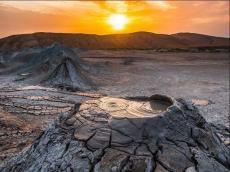|
|
TODAY.AZ / Society
Unique and rare minerals discovered in Azerbaijan's mud volcanoes
14 January 2020 [13:27] - TODAY.AZ

By Azernews
By Laman Ismayilova
Unique and rare minerals have been discovered inside mud volcanoes in Azerbaijan.
Mud volcanoes contain rare types of minerals in breccia, a rock composed of broken fragments of minerals or rock cemented together by a fine-grained matrix.
It may have a variety of different origins, as indicated by the named types including sedimentary breccia, tectonic breccia, igneous breccia, impact breccia, and hydrothermal breccia.
The studies revealed the presence of natural minerals, nonspecific sulfates, oxides, natural iron (silicate, hematite) as well as rare types of minerals. All these minerals are possibly formed under the influence of deep fluids.
An analysis of mud breccia was made by Azerbaijani and Ukrainian scientists as part of the project "Accessory mineralization of breccia in Azerbaijan's mud volcanoes".
The studies were conducted jointly with specialists from the Ukraine's Center for Problems of Marine Geology, Geoecology and Sedimentary Ore Formation.
Bubbling and belching away like witches’ cauldrons, mud volcanoes are unbelievably beautiful natural wonders.
Azerbaijan is home to some stunning and unique natural wonders. The Land of Fire has the greatest number of mud volcanoes worldwide.
At present, there are 365 mud volcanoes in Azerbaijan. Most volcanoes are active, and 43 of them are protected by the Azerbaijan Ministry of Ecology and Natural Resources. For security reasons, the admission of people there is prohibited.
Until the end of 2019, Azerbaijani scientists expect several volcanic eruptions, including Bozdag-Gobu volcanoes in Absheron district, Bahar in Alat village and Shikhzahirli volcano in Gobustan.
Tourists can get a unique panoramic view of the spectacular natural wonder in the Gobustan State Historical-Artistic Reserve.
The world’s largest mud volcanoes - Boyuk Khanizadagh and Turaghai - are both in Azerbaijan. Boyuk Khanizadagh erupted on October 10, 2001, shooting out flames for 300 meters in the air. It was the highest record for flames shot from a mud volcano.
NASA geologists studying Mars concluded that mud volcanoes of Azerbaijan are similar to uplands of the planet for their structure.
On September 5, 2004, the largest mud volcano in the territory of Azerbaijan was added into the Guinness World Records. Azerbaijan's rich fields of oil and gas condensate such as Lokbatan, Garadagh, Oil Rocks, and Mishovdag were also discovered near mud volcanoes.
The lava, mud, and liquid spewed by mud volcanoes are used as raw materials for chemical and construction industries, as well as pharmacology.
Enriched with specific components - mineral salts, organic substances, microelements, volcanic mud has medicinal properties that have a beneficial effect on the human body. Volcanic mud gives a great effect in the treatment of patients suffering from diseases of the peripheral and central nervous system, gastrointestinal tract, skin, etc.
URL: http://www.today.az/news/society/190046.html
 Print version
Print version
Connect with us. Get latest news and updates.
See Also
- 18 April 2024 [20:10]
Ombudsman representatives attend Environmental Security & Green World Conference - 17 April 2024 [16:47]
OSCE acting chairperson to visit Azerbaijan - 17 April 2024 [15:34]
Employability Week held at ADA University - 17 April 2024 [14:56]
Azerbaijan to increase number of high schools, gymnasiums in all regions, says Minister - 16 April 2024 [14:53]
MoU on establishment of Turkiye-Azerbaijan University approved - 16 April 2024 [12:17]
Opening ceremony of "Caspian Basin Studies" program held at ADA University - 15 April 2024 [12:55]
Heydar Aliyev Foundation takes over former footballer Vadim Vasilyev's treatment - 15 April 2024 [10:00]
Earthquake hits Azerbaijan's Imishli district - 14 April 2024 [15:37]
Zakir Hasanov met with the commander of the Jordanian Air Force - 14 April 2024 [14:18]
Azerbaijan, Jordan defence ministries clinch agreement
Most Popular
 EU acknowledges strategic significance of Baku International Sea Trade Port in Middle Corridor
EU acknowledges strategic significance of Baku International Sea Trade Port in Middle Corridor
 South Korea conducts live-fire exercises near borders of DPRK
South Korea conducts live-fire exercises near borders of DPRK
 Azerbaijan's AccessBank joins UN Global Compact
Azerbaijan's AccessBank joins UN Global Compact
 Azerbaijani Army units conduct inspection in military equipment
Azerbaijani Army units conduct inspection in military equipment
 TikTok closed in Kyrgyzstan
TikTok closed in Kyrgyzstan
 Navigating challenges in Azerbaijan's trade turnover amidst global uncertainties
Navigating challenges in Azerbaijan's trade turnover amidst global uncertainties
 Weapons & ammunition discovered in Khankendi
Weapons & ammunition discovered in Khankendi
